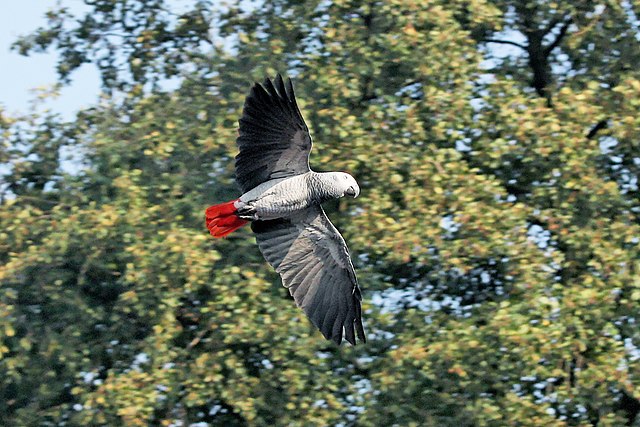When people first think of parrots, they most likely recall the colorful Macaws that are so widely displayed on television programs. However, the African Grey Parrot has long been sought after as a pet from as long ago as 4,000 years by Egyptians and ancient Greeks. King Henry VIII also had one.
The African Grey Parrot, Psittacus erithacus, is a medium-sized parrot that is native to the rainforests of West and Central Africa. While this parrot, particularly the Congo African Grey Parrot, is popular as a pet, they are no longer allowed to be caught in the wild because its population has been reduced.

Scientifically, these two subspecies are accepted:
- Congo African Grey Parrot(Psittacus erithacus erithacus) is larger and will grow to approximately 13 inches from the top of its head to the tips of its tail. They primarily grey but have cherry red tails and a black beak.
- Timneh African Grey Parrot(Psittacus erithacus timneh) is smaller and has a darker color, more like charcoal, and their tail feathers are more maroon.
Like the domesticated dog or cat, an African Grey holds onto their natural and instinctive behaviors. As an African Grey owner, it is imperative to understand that they are wild creatures with behaviors and instincts we can only begin to understand. Once we understand and accept these wild traits, we can begin to live together peacefully.
One trait that makes the African Grey as appealing as pets is their ability to mimic sounds and talk. While the ability to speak may be a source of enjoyment among parrot owners, experts don’t understand the importance of vocalizations to African Greys in the wild. More research concerning vocalizations is required before an informed decision can be made.
In the wild, the African Grey eats fruit, berries, nuts, and seeds. They also eat foliage from rainforest plants and are often seen foraging on the ground. They may also eat insects and are considered to be omnivores much like humans; they do enjoy exotic fruit in captivity.
They nest in the holes in trees, preferably ones that are over or very near water. They lay three or four eggs that remain in the nest for three months after they hatch. They live to be 50 years old, or older, so those choosing to own an African Grey need to be prepared for a lifetime commitment.
Any person considering purchasing an African Grey needs to realize that some behaviors are inbred, meaning the bird is going to do them regardless of how much training they receive. One of these behaviors is that they are very vocal, especially at dusk and at dawn.
While parrots can be trained to be less noisy, the only quiet parrot is one that is ill. Parrots are social animals and are very communicative using vocalizations to stay in contact with the flock. Their calls ensure that the remainder of the flock is nearby and alright. Birds that get very loud are trying to get a response from their flock-mates. Responding to them is a sure way to quiet them down but not necessarily the right thing to do with your pet… as it just encourages the loud noises from your bird.
Parrots only flock with their own species. They may live in smaller flocks, but will probably flock in larger groups. Roosting in trees, they split up into smaller flocks to forage during the day. As dusk approaches, they come together into larger flocks, often numbering in the thousands.
Another wild behavior that parrot owners need to be aware of is that parrots are sexual beings. They go through periods where they are moody and hormonal, particularly as they near breeding season. If they become aggressive all of a sudden, mating season may be near.
Biting is not a natural behavior for parrots in the wild unless absolutely necessary. They are non-confrontational and will flee rather than fight. However, if a captive parrot bites, it is generally out of fear. Another reason parrots might bite is that you’re coming too close to their territory. They may also bite if they are in pain or have not been trained not to bite.
Excessive screaming is another habit that is not normal in the wild. The only time a parrot will become loud in its original habitat is when it is trying to locate its flock if they become separated.
African Greys can sometimes develop neurotic behavior, but it’s not a normal occurrence in the wild. In captivity, an African Grey may develop behavioral problems if they are neglected. You have to realize that taking a wild animal out of its natural habitat and putting it in a cage with no freedom and little room may cause some problems. Even though your pet may have been captive-bred and hand-raised, wild instincts and innate tendencies still occur.
Further study of the African Grey Parrot is required to truly understand them and their behavior in the wild. That study will take place when scientists decide it’s time to learn more about them, to understand how captivity affects the birds, to try to maintain their habitat, or save the parrot in their native homes.
The biggest natural instinct they have is to fly, which is commonly taken away in captivity. Did you know a fully flighted parrot eats healthier than a clipped bird? It has more to burn off, and more ways to do it, just like a person who exercises craves healthier food for their body while the person sitting on the couch just wants junk food. You’ll be amazed at the changes that take place from a bird that can fly to one who is never given the chance.
